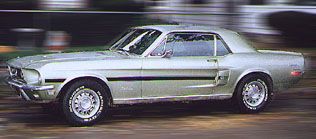
SAN FRANCISCO: The success story of the original Ford Mustangs, introduced mid-year in
1964, is legend in corporate automotive marketing folklore. A casebook study of vision, it
is based on careful analysis, combined with the ability to cut through the auto industry's
standard long lead times and the conservative "family car" mind set of Postwar
America.
The Mustang was so well
received that, though fastback and GT versions were introduced and some detail trim was
changed, the basic car continued as originally designed through the 1966 model year.
1967 was going to be a
pivotal year for the Mustang. For the first time since its inception, there was going to
be some competition - BIG COMPETITION. Chevy was readying its Camaro and Pontiac had its
Camaro derived Firebird on the board. Chrysler's original Valiant based, fish bowl
fastback Barracuda, was being replaced with a well styled, three model armada
(convertible, coupe and fastback) with guns aimed directly at Mustang.
Even the Lincoln Mercury
division of Ford would have the Cougar, its own up-market coupe version of the Mustang.
The '67 Mustang would have to be changed to look newer and hotter, without changing much
of the greenhouse area and floor plan, or eliminating any of the styling cues that were
identified with the already quite popular car.
Though restyled from the
rocker panels to the window sills, the '67 and '68 models retained most of the styling
elements from the earlier cars. While the body got marginally bigger, achieved by adding
more overhang on each end and curved sheet metal on the sides, the chassis specifications
never changed.
The new grille looked
similar to the first Mustangs. It was taller and wider and jutted out from the top at more
of an angle, which made the headlights appear to be deeper set. The sideways "U"
shaped depression that trailed off into simulated chrome "scoops" on the first
series was exaggerated for effect and given a real scoopy look with a pair of deep finned
ports behind each door.
The rear panel above the
bumper was remade concave to resemble the aerodynamic Kamm-back designs found on the Ford
GT40 and racing Cobra coupes. The most changed model was the 2 + 2 hard top that became a
true fastback with a roof that sloped all of the way back to the edge of the concave rear
panel.
Performance was increased
to keep the Mustang the fastest pony car. While buyers could still opt for a six or small
V8, performance versions of the 289 cube V8 could be ordered in 225 and 271 HP models. If
straight line performance was high on your wish list a new 320 horse 390 cube big block
Thunderbird Special V8 was available. Shelby versions included an up rated 271 horse small
block in the GT350 and a 428 cube big block in the GT500. In addition, about 50 GT500s
were built to order with the hotter 427 medium riser engine.
Changes were kept to a
minimum for 1968 and most were due to newly implemented smog and safety regulations. The
smog requirements differed from state to state, but all cars had to have a federally
mandated restraint system ( that usually reduced itself to a tangled pile of belts on the
back floor ) and "breakaway" interior components. Side marker lights traded
night visibility for cluttered looks.
For '68 there were more
special performance models. A horsepower race had developed when Chevy introduced its 396
cubic inch Rat motor in the Camaro and Pontiac brought out its Firebird 400. Not to be
outdone, Ford installed a new 335 horse, 428 Cobra Jet V8 engine where the 390s had been
in the '67 Mustangs.
Beside the GT and GTA
(automatic) versions that had been around for a few years, there was a California Special
(GT/CS), a Shelby-esque trim package on a standard 2 door sold only in California, plus
the High Country Special, basically a re-worked California Special sold through Colorado
Ford dealers and the "Cobra Jet" fastback offered from mid 1968.
Next a convertible was
added to the Shelby GT line. It had a factory roll bar and could be had with either small
block (GT350) or 428 cu. in. big block (GT500). A new model, brought out later in the
year, was the GT500KR ( King of the Road ) that had an advanced ram-air hood feeding a 428
cube Cobra Jet engine. Ford still had the top pony.
What this "New"
Mustang is all about is nostalgia for the west coast "thirty- something" crowd.
They were the secondhand cars that these folks drove to high school. Let's pop a Led
Zeppelin tape into the stereo and cruise over to the beach and look for Sue the
cheerleader and the rest of the gang (boy, gang sure had a different connotation in those
days). Sue might be there today, but it will probably be with her second husband and the
three daughters by her first, the oldest of which looks surprisingly like Sue did when Led
Zep was at the top of the charts...A quick glance in the rear view mirror to make sure the
hair is just right ... Wow, where did all that space between the shades and the hair come
from?... Oh, well, at least the Mustang looks the same! By Rick Feibusch ©
AutoWire.Net - San Francisco

Byline: By Rick Feibusch © AutoWire.Net - San Francisco
Column Name: "The Classic Drive"
Topic: Mustang - The Second Series
Word Count: 884
Photo Caption: 1968 Ford Mustang California Special
Photo Credits: Rick Feibusch
Series #: 1999 - 61


|
